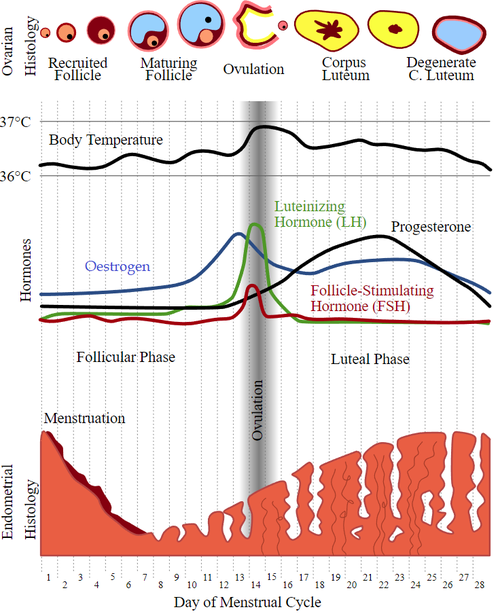Difference between revisions of "Ovulation"
(→Meaning) |
|||
| (8 intermediate revisions by 2 users not shown) | |||
| Line 1: | Line 1: | ||
| − | + | ==Key Stage 3== | |
| + | ===Meaning=== | ||
| + | '''Ovulation''' is one of the stages of [[conception]] and is when an [[ovum]] is released from an [[ovary]]. | ||
| + | |||
| + | ===About Ovulation=== | ||
| + | : The [[ovum]] travels along the edge of the [[oviduct]], aided by [[cilia]], following [[ovulation]]. | ||
| + | : '''Ovulation''' takes place on the 14th day of the [[Menstrual Cycle|menstrual cycle]]. | ||
| + | |||
| + | ==Key Stage 4== | ||
| + | ===Meaning=== | ||
| + | '''Ovulation''' is when an [[ovum]] is released by a [[follicle]] in the [[ovary]]. | ||
| + | |||
| + | ===About Ovulation=== | ||
| + | : Prior to '''ovulation''' [[Follicle Stimulating Hormone|follicle stimulating hormone]] causes the [[follicle]]s to grow and the [[ovum]] to mature. | ||
| + | : '''Ovulation''' is triggered by a sudden increase in [[Luteinising Hormone|luteinising hormone]] around the 14th day of the [[Menstrual Cycle|menstrual cycle]] which causes the [[ovum]] to be released from a [[follicle]]. | ||
| + | : Following '''ovulation''' the [[ovum]] travels along the edge of the [[oviduct]] swept along by [[cilia]]. | ||
| + | |||
| + | {| class="wikitable" | ||
| + | |- | ||
| + | |[[File:MenstrualCycleGraph2.png|center|500px]] | ||
| + | |- | ||
| + | | style="height:20px; width:500px; text-align:left;" |A [[graph]] showing changes during the [[Menstrual Cycle|menstrual cycle]] including '''ovulation'''. The [[graph]] notes: | ||
| + | : The stages of [[follicle]] growth and [[ovulation]]. | ||
| + | : The [[Body Temperature|body temperature]]. | ||
| + | : The [[hormone]] levels. | ||
| + | : The relative thickness of the [[Uterus|uterine wall]]. | ||
| + | |} | ||
| + | |||
| + | ===References=== | ||
| + | ====AQA==== | ||
| + | |||
| + | :[https://www.amazon.co.uk/gp/product/1782946381/ref=as_li_tl?ie=UTF8&camp=1634&creative=6738&creativeASIN=1782946381&linkCode=as2&tag=nrjc-21&linkId=5ec5fc3f6429e30c1d9ab9bca2bccf93 ''Ovulation, page 189, GCSE Combined Science Trilogy; Biology, CGP, AQA ''] | ||
| + | :[https://www.amazon.co.uk/gp/product/1782945954/ref=as_li_tl?ie=UTF8&camp=1634&creative=6738&creativeASIN=1782945954&linkCode=as2&tag=nrjc-21&linkId=100574c08fbbb64318256eb79ed61a76 ''Ovulation, page 225, GCSE Biology, CGP, AQA ''] | ||
| + | :[https://www.amazon.co.uk/gp/product/1782945598/ref=as_li_tl?ie=UTF8&camp=1634&creative=6738&creativeASIN=1782945598&linkCode=as2&tag=nrjc-21&linkId=ad276ad49df77ab4b40ab4fd0fe10130 ''Ovulation, page 63, GCSE Combined Science; The Revision Guide, CGP, AQA ''] | ||
| + | :[https://www.amazon.co.uk/gp/product/1782945563/ref=as_li_tl?ie=UTF8&camp=1634&creative=6738&creativeASIN=1782945563&linkCode=as2&tag=nrjc-21&linkId=9a1d023a374038e6072f33c4f3cf808b ''Ovulation, page 77, GCSE Biology; The Revision Guide, CGP, AQA ''] | ||
| + | :[https://www.amazon.co.uk/gp/product/0198359373/ref=as_li_tl?ie=UTF8&camp=1634&creative=6738&creativeASIN=0198359373&linkCode=as2&tag=nrjc-21&linkId=952a73bbb09d222ecc4b50d200679849 ''Ovulation, pages 168-171, 174, GCSE Biology; Third Edition, Oxford University Press, AQA ''] | ||
| + | :[https://www.amazon.co.uk/gp/product/1471851362/ref=as_li_tl?ie=UTF8&camp=1634&creative=6738&creativeASIN=1471851362&linkCode=as2&tag=nrjc-21&linkId=7d78d70a2044ee9982dae010c94af92a ''Ovulation, pages 17, GCSE Combined Science Trilogy 2, Hodder, AQA ''] | ||
| + | |||
| + | ====Edexcel==== | ||
| + | |||
| + | :[https://www.amazon.co.uk/gp/product/1292120207/ref=as_li_tl?ie=UTF8&camp=1634&creative=6738&creativeASIN=1292120207&linkCode=as2&tag=nrjc-21&linkId=22455ff53961978667722edaa64c0be5 ''Ovulation, page 146, GCSE Biology, Pearson, Edexcel ''] | ||
| + | |||
| + | ====OCR==== | ||
| + | :[https://www.amazon.co.uk/gp/product/0198359810/ref=as_li_tl?ie=UTF8&camp=1634&creative=6738&creativeASIN=0198359810&linkCode=as2&tag=nrjc-21&linkId=d768d99f1a06f7c12fab40e5aef85a55 ''Ovulation, pages 101, 104-105, Gateway GCSE Biology, Oxford, OCR ''] | ||
Latest revision as of 19:34, 20 February 2022
Contents
Key Stage 3
Meaning
Ovulation is one of the stages of conception and is when an ovum is released from an ovary.
About Ovulation
- The ovum travels along the edge of the oviduct, aided by cilia, following ovulation.
- Ovulation takes place on the 14th day of the menstrual cycle.
Key Stage 4
Meaning
Ovulation is when an ovum is released by a follicle in the ovary.
About Ovulation
- Prior to ovulation follicle stimulating hormone causes the follicles to grow and the ovum to mature.
- Ovulation is triggered by a sudden increase in luteinising hormone around the 14th day of the menstrual cycle which causes the ovum to be released from a follicle.
- Following ovulation the ovum travels along the edge of the oviduct swept along by cilia.
A graph showing changes during the menstrual cycle including ovulation. The graph notes:
|
References
AQA
- Ovulation, page 189, GCSE Combined Science Trilogy; Biology, CGP, AQA
- Ovulation, page 225, GCSE Biology, CGP, AQA
- Ovulation, page 63, GCSE Combined Science; The Revision Guide, CGP, AQA
- Ovulation, page 77, GCSE Biology; The Revision Guide, CGP, AQA
- Ovulation, pages 168-171, 174, GCSE Biology; Third Edition, Oxford University Press, AQA
- Ovulation, pages 17, GCSE Combined Science Trilogy 2, Hodder, AQA
